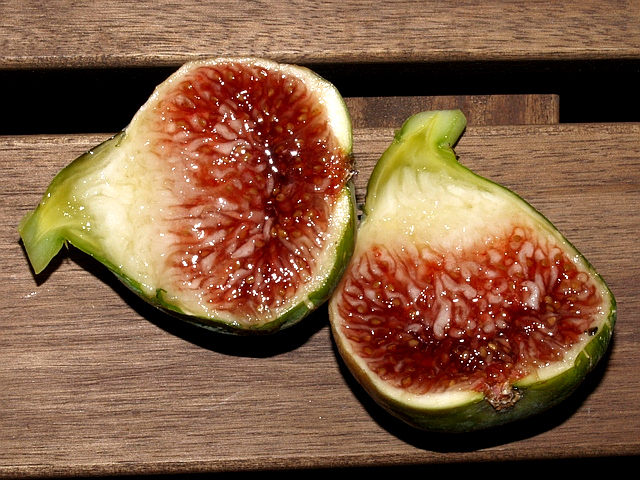This site contains affiliate links for which I may be compensated.
Oeil De Perdrix
Oeil De Perdrix Information


-
Possible Synonyms / AKA:
Eye of the Partridge, Pheasant Eye -
Introduced By:
-
Origin:
Spain -
Main Flavor Group:
Exotic - Deep, rich flavor often found in varieties like Black Madeira and Preto, delivering an intense, complex taste that feels luxurious and distinctive. -
Family Group:
-
Fig Type:
Common - Self fertile and will grow anywhere conditions are suitable -
Cold Hardy:
N/A -
Container Variety:
N/A -
Easy Rooting:
N/A -
Main Season:
any -
Availability:
N/A -
Breba Crop:
N/A -
Seed Crunch:
N/A -
Eye:
closed -
Skin Toughness:
N/A -
Fruit Size:
Small to medium -
Rain Resistance:
N/A -
Tree Vigor:
N/A -
External Links:
Description
It seems that for the genetic indicator is the same variety of fig tree than the Setjola. Very decorative tree of harmonious development with tortured trunk that remembers those of the olive trees. Medium size to small, in poor or dry terrains. Great development in fresh and deep terrains. It likes the calcareous terrains and it bears well the sea exposures. Medium, normally trilobular and very thick leaves, with the hems as tooth of saw.
Delicate fig fruit, around 30 and 50 gr. White yellowish skin color over greenesh background. It has thin skin, red and sweet flesh, pleasant taste, better taste when it is eaten with its own skin. It matures at the end of July first of August. Good to dry even if today it is abandoned. In July, before maturing the figs they have the skin of a green greyish silvered color and they are covered with thin hairs. Now, the eye is still completely white. This allows to distinguish it from other varietie.
Condit Monograph
OEil DE Perdrix (Eye of the Partridge, Pheasant Eye). Described by La Brousse (1774), Hogg (1866), G. S. (1869), Barron (1868c, 1891), and Eisen (1888, 1901). Before 1866, this French variety was introduced into England, where it fruited and received the comments of various horticulturists. Barron reported it to be similar to Ischia White in that the tree ''fruited as profusely as a gooseberry bush''; the fruit had a large, prominent eye, and was of second quality. G. S. found the figs to be ''without any peculiar beauty, such as one would expect from the name.''
P.I. No. 18,842 of the Chiswick collection was labeled OEil DE Perdrix. Scions of this variety, obtained from the Angleton, Texas, station, produced fruit in 1944 at Riverside. The following short description is from notes taken at Chico and Riverside in comparison with the account of Hogg.
Second-crop figs below medium to small, short-turbinate to oblate; neck short and thick, or none; stalk short; ribs only slightly elevated; eye medium to large, open, scales violet; surface dull; color chestnut brown to mahogany; pulp light strawberry; flavor insipid; quality fair to poor.
Caprified figs larger, with deep-strawberry pulp, rich in flavor; quality good, but figs of no particular value.
OEil DE Perdrix (Eye of the Partridge, Pheasant Eye). Described by La Brousse (1774), Hogg (1866), G. S. (1869), Barron (1868c, 1891), and Eisen (1888, 1901). Before 1866, this French variety was introduced into England, where it fruited and received the comments of various horticulturists. Barron reported it to be similar to Ischia White in that the tree ''fruited as profusely as a gooseberry bush''; the fruit had a large, prominent eye, and was of second quality. G. S. found the figs to be ''without any peculiar beauty, such as one would expect from the name.''
P.I. No. 18,842 of the Chiswick collection was labeled OEil DE Perdrix. Scions of this variety, obtained from the Angleton, Texas, station, produced fruit in 1944 at Riverside. The following short description is from notes taken at Chico and Riverside in comparison with the account of Hogg.
Second-crop figs below medium to small, short-turbinate to oblate; neck short and thick, or none; stalk short; ribs only slightly elevated; eye medium to large, open, scales violet; surface dull; color chestnut brown to mahogany; pulp light strawberry; flavor insipid; quality fair to poor.
Caprified figs larger, with deep-strawberry pulp, rich in flavor; quality good, but figs of no particular value.
If you'd like your banner to be shown here and throughout Fig Database, send us a message.
Photos Add Your Image
No Images Found
YouTube Videos
No Videos Found









